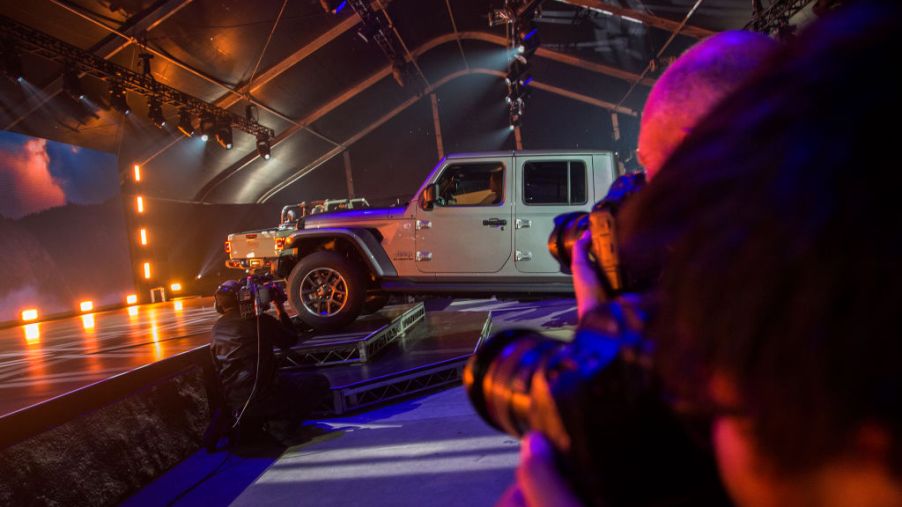
Should You Buy a Jeep Gladiator Instead of a Wrangler?
From the start, the 2020 Jeep Gladiator made a strong showing in the mid-size truck category. It made the dream of Jeep fans who wanted a truck a reality. And, at first glance, the Jeep Gladiator is basically a stretched Jeep Wrangler with a bed, according to Jalopnik.
So, if you’re in the market for a Jeep and you like both models, which is the better one to buy? Let’s look at the Gladiator’s impressive characteristics and compare them to the Wrangler’s in order to make a decision.
How similar are the Jeep Gladiator and the Wrangler?
The front half of the Jeep Gladiator is nearly identical to the Wrangler, with the exception of a small change in the grille, axle tube thickness and some upgrades for the Rubicon variant.
Both Jeeps have body-on-frame construction, multi-link solid-axle suspension in front and rear, and the 285-hp 3.6-liter Pentastar V6 engine with a choice of a six-speed manual or an eight-speed automatic transmission.
Both the Gladiator and Wrangler feature removable doors and roof. And both Jeeps’ interiors are straightforward but high-quality interiors. They share odd bits, like switches displaying a Wrangler icon or the Wrangler rear seat entry that remained unchanged for the longer Gladiator.
But the Gladiator possesses so many characteristics that make it a true truck. FCA engineers increased the truck’s frame to make it 31 inches longer than the Wrangler. More than 19 inches of the added length exists in the wheelbase. The pickup’s fuel lines, brake lines, and rear driveshaft have all been extended, too.
The Gladiator is six inches longer than the Chevrolet Colorado and Toyota Tacoma. It also has honest-to-goodness truck heft, weighing 400 to 500 pounds more than both rivals. This extra weight helps stabilize the truck during towing.
Other differences between the Wrangler and Gladiator is that the latter has been designed with stiffer suspension, special shocks, a stronger axle tube, and a thicker sway bar. The Gladiator also shares all five suspension links with the Ram 1500.
All of these differences point to a truck that has a best-in-class towing capacity of 7,680 pounds. The Gladiator 4X4 also takes best-in-class for a payload capacity of 1,600 pounds.
The Jeep Gladiator takes on the highway
Jalopnik was pleased with the Jeep truck’s ride quality on the road and noted that it was just as good as the Wrangler’s. Its acceleration was responsive and the powertrain proved itself to be muscular and solid. The Gladiator’s additional wheelbase length proved to be an advantage on the straightaway because the truck didn’t pitch over bumps.
The same extra length between the front and rear axles became a slight liability on winding roads as were the truck’s height, flexible springs, and solid axles. Steering on the curves, according to Jalopnik, was loose and imprecise in part due to an old-timey steering gearbox.
The Gladiator masters the trail
The much-anticipated part of Jalopnik’s test drive took writer David Tracy to an extremely muddy course in California designed by the folks at Jeep. He was lucky enough to drive three out of the four Gladiator models: the Sport, Overland, and Rubicon.
The Sport and Overland variants were sure-footed with great traction on the mucky, rutted trail. Both trim levels have excellent offroad metrics, with a 40.8-degree approach angle, a 25-degree departure angle, and 10 inches of ground clearance. At 18.4 degrees, the breakover angle could be better but the truck’s longer wheelbase may be to blame for this.
The Jeep Wrangler, by comparison, has an approach angle of 44 degrees, breakover angle of 27.8 degrees, departure angle of 37 degrees, and ground clearance of 10.9 inches.
The Rubicon was outfitted with the same hardware as the Wrangler Rubicon. It had a Rock-Trac transfer case with a 4-to-1 low range ratio that provides increased crawl ratios ideal for rock crawling. It was equipped with Dana 44 wide-track axles with locking differentials and a 4.10-to-1 gearing to provide plenty of low-speed torque.
Additional goodies include an electronically disconnecting sway bar, 33-inch Falken mud-terrain tires, skid plates, and monotube Fox shocks. The Gladiator Rubicon’s metrics were almost as remarkable as the Wrangler’s with an approach angle of 43.4 degrees, breakover angle of 25, and departure angle of 20.3 plus an amazing 11 inches of ground clearance.
With the transfer case in low range, Tracy felt that the Gladiator could crawl up anything he steered it toward. The giant tires and locking diffs allowed it to handle sharp inclines. When the sway bar is disconnected, the truck’s wheels grip whatever terrain is beneath them. The Gladiator’s offroad performance convinced Tracy that it indeed was the champion of low-speed offroading.
Which Jeep should you buy?
The 2020 Jeep Gladiator‘s base model the Sport starts at $35,040 while the two-door Wrangler Sport starts at $28,295.
Both Jeeps offer outstanding offroad performance and the metrics to go along with it. It could be difficult to choose between the two if offroading is your only consideration. But if you want top-of-the-segment towing and hauling capability in a truck that also plays nicely on the highway, we think the Gladiator is the Jeep to choose.


